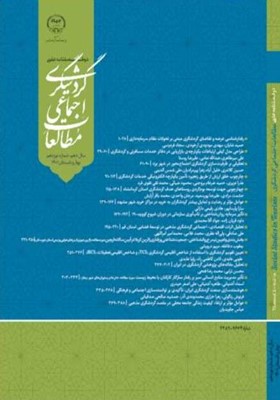تحلیل اثرات اقتصادی- اجتماعی گردشگری مذهبی در توسعۀ فضایی استان قم
محورهای موضوعی :علی صادقی 1 , ولی اله نظری 2 , محمد غلامی 3 , محمدامیر امراللهی 4
1 - دانشگاه فرهنگیان
2 - دانشگاه فرهنگیان
3 - دانشگاه پیام نور
4 - دانشگاه آزاد اسلامی واحد قزوین
کلید واژه: گردشگری مذهبی, توسعه فضایی, اثرات اقتصادی- اجتماعی, تحلیل سلسله مراتبی, قم.,
چکیده مقاله :
در پژوهش حاضر اثرات اقتصادی- اجتماعی گردشگری مذهبی بر توسعه فضایی استان قم مورد مطالعه و بررسی قرار گرفته است. روش تحقيق حاضر از نوع توصیفی - تحلیلی و ابزار گردآوري اطلاعات پرسشنامه محقق ساخته است كه با روش تحلیل سلسله مراتبی طراحی شده است. در این پژوهش معیارهای مورد نیاز در دو بخش اقتصادی با پنج زیرمعیار «افزایش اشتغال، افزایش درآمد، کاهش تورم، افزایش تولیدات منطقهای و مشارکت بخش خصوصی»، و بخش اجتماعی با سه زیرمعیار «افزایش امنیت، توسعۀ فرهنگ اجتماعی، بهبود خدمات و زیرساختها»، به منظور سنجش و ارزیابی اثرات گردشگری مذهبی در دو بخش اقتصادی و اجتماعی بر توسعه فضایی استان قم گردآوری و تدوین شده اند. نتایج بررسی اولویت بندی این معیارها، نشان از بالا بودن تأثیر بخش اقتصادی گردشگری مذهبی بر توسعه فضایی استان قم دارد. به اعتقاد کارشناسان هر چه توان اقتصادی مردم بیشتر باشد، تأثیر مطلوب آن بر بخش اجتماعی جامعه نیز قابل مشاهده و درک میباشد. همچنین این معیارها در محدوده مورد مطالعه که بخشهای تشکیل دهنده استان قم میباشد نیز ارزیابی و اولویتبندی شدند که بخش مرکزی در پنج معیار از هشت معیار شناسایی شده، دارای بیشترین تأثیر از گردشگری مذهبی در بخش های اقتصادی و اجتماعی بر توسعه فضایی خود میباشد. این نتیجه نشان میدهد که بخش مرکزی استان ( شهر قم) به عنوان مرکز و کانون گردشگری برای گردشگران، فاصله زیادی در توسعه با سایر بخشهای استان دارد. این فاصله موجب بروز مشکلاتی در آینده در این بخش و به خصوص در شهر قم خواهد شد.
This descriptive-analytical study sought to investigate the socio-economic impacts of religious tourism on the spatial development of Qom province, using a researcher-developed questionnaire designed via Analytical Hierarchy Process to collect its required data. To this end, the required criteria were developed at two levels: the economic level comprising of five sub-criteria, including "Increase in employment, increase in incomes, reduction in inflation, increase in regional production", and: private sector participation", and the social level comprising three sub-criteria, including "Increasing the security, increasing the social culture, improving services and infrastructure". The results of surveying the priority of these criteria indicated the high impact of the economic element of tourism on the spatial development of Qom province. According to experts, the more economic power the people have, the better its impact would be on the social and environmental sectors of the society. Also, the criteria were also evaluated and prioritized within the study area that formed different districts of Qom province. Accordingly, it was found that the spatial development of the central district of the province (Qom city) was mostly influenced by religious tourism in terms of 5 criteria out of the 8 criteria identified in the study, suggesting that Qom, as the hub of religious tourism of the province, outweighs other parts of the province in terms of development, which may cause some problems in the future for the development of tourism in Qom province.
